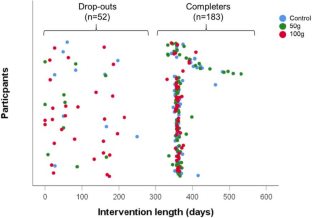2024-06-25 ペンシルベニア州立大学(PennState)
<関連情報>
- https://www.psu.edu/news/research/story/got-prunes-prunes-may-preserve-bone-density-and-strength-older-women/
- https://link.springer.com/article/10.1007/s00198-024-07031-6
- https://www.sciencedirect.com/science/article/pii/S0002916523036092?via%3Dihub
閉経後女性を対象とした12ヵ月間の無作為化比較試験において、プルーンは脛骨の皮質密度と推定強度を維持した: プルーン研究 Prunes preserve cortical density and estimated strength of the tibia in a 12-month randomized controlled trial in postmenopausal women: The Prune Study
Kristen J. Koltun,Nicole C. A. Strock,Connie Weaver,Hang Lee,Nancy I. Williams,Connie J. Rogers,Janhavi Damani,Mario G. Ferruzzi,Cindy H. Nakatsu & Mary Jane De Souza
Osteoporosis International Published:13 February 2024
DOI:https://doi.org/10.1007/s00198-024-07031-6

Abstract
Summary
Non-pharmacological therapies, such as whole-food interventions, are gaining interest as potential approaches to prevent and/or treat low bone mineral density (BMD) in postmenopausal women. Previously, prune consumption preserved two-dimensional BMD at the total hip. Here we demonstrate that prune consumption preserved three-dimensional BMD and estimated strength at the tibia.
Purpose
Dietary consumption of prunes has favorable impacts on areal bone mineral density (aBMD); however, more research is necessary to understand the influence on volumetric BMD (vBMD), bone geometry, and estimated bone strength.
Methods
This investigation was a single center, parallel arm 12-month randomized controlled trial (RCT; NCT02822378) to evaluate the effects of 50 g and 100 g of prunes vs. a Control group on vBMD, bone geometry, and estimated strength of the radius and tibia via peripheral quantitative computed tomography (pQCT) in postmenopausal women. Women (age 62.1 ± 5.0yrs) were randomized into Control (n = 78), 50 g Prune (n = 79), or 100 g Prune (n = 78) groups. General linear mixed effects (LME) modeling was used to assess changes over time and percent change from baseline was compared between groups.
Results
The most notable effects were observed at the 14% diaphyseal tibia in the Pooled (50 g + 100 g) Prune group, in which group × time interactions were observed for cortical vBMD (p = 0.012) and estimated bone strength (SSI; p = 0.024); all of which decreased in the Control vs. no change in the Pooled Prune group from baseline to 12 months/post.
Conclusion
Prune consumption for 12 months preserved cortical bone structure and estimated bone strength at the weight-bearing tibia in postmenopausal women.
閉経後女性を対象とした12ヵ月ランダム化比較試験において、プルーンは脛骨の骨密度を維持した:プルーン研究 Prunes preserve hip bone mineral density in a 12-month randomized controlled trial in postmenopausal women: the Prune Study
Mary Jane De Souza , Nicole CA Strock , Nancy I Williams , Hang Lee , Kristen J Koltun , Connie Rogers , Mario G Ferruzzi , Cindy H Nakatsu , Connie Weaver
The American Journal of Clinical Nutrition Available online: 11 July 2022
DOI:https://doi.org/10.1093/ajcn/nqac189

ABSTRACT
Background
Dietary consumption of prunes has favorable impacts on bone health, but more research is necessary to improve upon study designs and refine our understandings.
Objectives
We evaluated the effects of prunes (50 g or 100 g/d) on bone mineral density (BMD) in postmenopausal women during a 12-mo dietary intervention. Secondary outcomes include effects on bone biomarkers.
Methods
The single-center, parallel-arm 12-mo randomized controlled trial tested the effects of 50 g and 100 g prunes compared with a control group on BMD (every 6 mo) and bone biomarkers in postmenopausal women.
Results
In total, 235 women (age 62.1 ± 5.0 y) were randomly allocated into control (n = 78), 50-g prune (n = 79), or 100-g prune (n = 78) groups. Compliance was 90.2 ± 1.8% and 87.1 ± 2.1% in the 50-g and 100-g prune groups. Dropout was 22%; however, the dropout rate was 41% for the 100-g prune group (compared with other groups: 10%, control; 15%, 50 g prune; P < 0.001). A group × time interaction for total hip BMD was observed in control compared with 50-g prune groups (P < 0.05) but not in control compared with 100-g prune groups (P > 0.05). Total hip BMD decreased –1.1 ± 0.2% in the control group at 12 mo, whereas the 50-g prune group preserved BMD (–0.3 ± 0.2%) at 12 mo (P < 0.05). Although hip fracture risk (FRAX) worsened in the control group at 6 mo compared with baseline (10.3 ± 0.5% compared with 9.8 ± 0.5%, P < 0.05), FRAX score was maintained in the pooled (50 g + 100 g) prune groups.
Conclusions
A 50-g daily dose of prunes can prevent loss of total hip BMD in postmenopausal women after 6 mo, which persisted for 12 mo. Given that there was high compliance and retention at the 50-g dosage over 12 mo, we propose that the 50-g dose represents a valuable nonpharmacologic treatment strategy that can be used to preserve hip BMD in postmenopausal women and possibly reduce hip fracture risk. This trial was registered at clinicaltrials.gov as NCT02822378.


